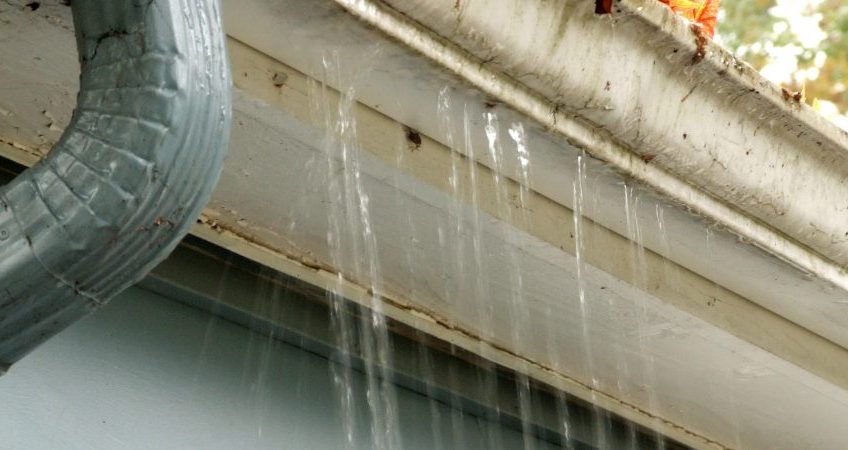Ever notice water spilling over the sides of your gutters or strange stains on your siding after a good rain? You’re not alone—and it usually means one thing: your gutters are leaking. While it might seem like a small issue, those leaks can quietly lead to much bigger problems—think foundation cracks, rotting wood, and even mold creeping into your home. But don’t stress just yet! In this post, we’ll walk through the most common reasons gutters leak and, more importantly, how you can fix them before they cause real trouble.
1. Clogged Gutters
The most common cause of gutter leakage are clogged gutters. When leaves, dirt, and other debris accumulate in your gutters the water doesn’t have a clear path to travel through and leave through the downspout. Clogs cause water to spill over the top of your gutters, run down the sides of your gutters, or drip down the side of your home. To check if a clogged gutter is the problem of your leakage, you simply need to look inside the gutters to identify potential blockages. Of course, if you’re not comfortable doing that yourself, give a professional team of gutter repair and installation specialists a call.
2. Separated Joints
Gutters and downspouts are connected via joints and over time these joints can hold debris and water causing blockages for wain water to escape. This build-up can actually cause the joints to deteriorate and cause further issues. If the damage isn’t too bad, you can use caulking to fill the separation to once again allow water to flow freely. However, chances are the joints will need to be replaced.
3. Gutter Sloping
Gutter sloping is an art and a science, and if it’s done incorrectly, or your gutters have sagged over time, water can pool in the gutters. Pooling water can cause gutter rust and deterioration, leaving weak spots for water to leak from. Luckily, if your gutters are improperly sloping, and they haven’t started deteriorating you don’t have to completely replace them; just contact the professionals to properly adjust your gutter slope.
4. Loose Gutters
Having gutters that aren’t fully secured to your house can often make it look like the gutters are leaking, however, what’s actually happening is the water from your roof is missing the gutter completely and falling in between the gutter and the house. The solution to this issue is to reattach the gutters to your home’s fascia – creating a tighter seal for water to run off. Of course, further repairs may need to be completed if your home’s fascia has deteriorated, but that analysis will be made once you’re closely looking at the gutters.
5. Holes and Gapping
If your gutters have holes or gaps, the issue is a little easier to identify than some of the others on our list. After all, if there is a hole (or several) the water will escape in small sections, unlike the water leakage from having loose gutters or incorrectly sloped gutters. The solutions for repairing gutter holes and gapping are varied, but your specialist will either repair the holes or suggest a replacement if the repairs would not be successful.
If you’re noticing leaking gutters, you need to address the issue sooner rather than later. Let’s talk about what happens when they go unchecked.
What Damage Can a Leaking Gutter Cause
Foundation Damage
How Water Accumulates Near the Foundation
When gutters are clogged or your yard doesn’t slope away from the house like it should, all that rainwater has nowhere to go—except straight down along your foundation. And trust me, that’s not where you want it.
Foundation Damage – What You Should Look For
- Cracks: They might be vertical or horizontal, and either way, they’re a warning sign.
- Bowing Walls: Water pressure can actually push your walls inward. Not good.
- Settling: Uneven settling can cause sloping floors or misaligned door frames as the foundation shifts.
- Dampness and Mold: Accumulated moisture increases mold growth risk and affects indoor air quality.
Cost of Foundation Repairs
The cost of foundation repairs varies depending on the extent of the issues. Here are some price ranges:
- Minor Cracks: Repairing small cracks can cost between $200 and $800.
- Bowing Walls: Expect anywhere from $1,000 to $10,000.
- Major Settling Issues: Depending on the severity, extensive repairs could be $5,000 to $20,000 or more.
Siding and Exterior Wall Damage
How Water Damages Siding
Leaky gutters can damage siding, causing warping, swelling, and rot in wood materials.
Impact on Different Siding Materials
Water damage affects different siding materials differently. Wood siding can rot, vinyl siding is resistant but not immune to fading and mold growth, and fiber cement is more durable but can crack if water seeps in.
Here’s a quick look at how different materials are affected:
| Siding Material | Possible Damage |
| Wood | Rot, warping, and mold |
| Vinyl | Fading, mold, and cracks |
| Fiber Cement | Cracking and deterioration |
Siding Damage – What to Look For
Siding damage may not be visible from a distance. We should look for specific signs that our siding is water-damaged:
- Stains near the base of the siding.
- Blistering or peeling paint.
- Mold or mildew growth on the surface.
Roof Damage
How Leaky Gutters Affect the Roof
Leaks in gutters can cause water to overflow, weaken roofing materials, and cause shingles to curl, crack, or detach. In colder weather, accumulated water can increase the risk of ice dams, forcing water under shingles and causing more damage.
Leaks to Enter the Attic
Leaky gutters can let moisture seep into attics, foster mold growth, and damage insulation and wooden beams. If left unchecked, leaks can compromise the entire attic structure.
Fascia Rot
Fascia boards protect roof edges and can rot due to gutter leaks, weakening roof support, and causing more damage. Signs of rot are discoloration, soft spots, and visible cracks. Replacing rotting fascia early can prevent more extensive repairs.
Visuals of Roof Damage
Identifying roof damage early is key. We can look for several visual indicators:
- Curling or Missing Shingles: These may mean water damage.
- Stains on the Roof: Dark spots can indicate stagnant water.
- Mold Growth: If we see mold, it often means moisture issues.
Landscape and Soil Erosion
When gutters don’t work, all that runoff water can trash your yard, damage your hardscape, and invite unwanted pests. Here’s what to watch for:
Landscaping Damage
- Drowned flower beds and shrubs from constant runoff
- Soil erosion that washes away nutrients plants need
- Wilting or dying plants that can’t absorb water or nutrients properly
- Loose or exposed roots due to missing topsoil
Water Pooling and Pest Problems
- Standing water around your home creates breeding grounds for mosquitoes
- Ants and rodents are drawn to moist spots for food and nesting
Hardscape Issues: Walkways & Driveways
- Cracks and erosion in concrete or stone from poor drainage
- Uneven surfaces that become tripping hazards
- Stained or discolored concrete where water repeatedly flows or pools
What to Look For Outside
- Thin patches of grass or bare soil
- Pooling water near the home’s perimeter
- Shifting or sinking sections of your paths or patios
Interior Water Damage
Once water gets into your home, the damage adds up fast—and it’s not always where you expect it. Here’s how leaky gutters lead to interior trouble:
Damage to Your Stuff
- Furniture can warp or bend • Electronics can short circuit or malfunction • Clothing, bedding, and linens can take on water damage
Health Risks from Mold & Mildew
- Wet environments = perfect conditions for mold and mildew to grow
- Mold exposure can cause respiratory issues, allergies, and asthma attacks
Signs of Interior Water Damage
- Dark stains on ceilings or walls
- Peeling paint or bubbling wallpaper
- Warped floors or soft spots underfoot• A musty smell in certain rooms or near the baseboards
How to Fix and Prevent Leaky Gutters
Keeping your gutters in shape doesn’t have to be a big deal, but ignoring them will cost you. Here’s how to stay ahead of leaks, clogs, and water damage:
Regular Gutter Inspections & Maintenance
- Check your gutters twice a year—once in spring and once in fall
- Look for rust, cracks, loose fittings, and blockages
- Use a ladder and trowel to clear out leaves and debris safely
- Don’t forget to reseal joints and adjust gutter angles to ensure proper flow
Benefits of Hiring a Pro
- Professionals can spot hidden problems before they become expensive
- They’ll do a thorough cleaning and handle repairs safely
- Many offer warranties so that you can have peace of mind
- Saves you the time, hassle, and risk of climbing up yourself
Invest in Gutter Protection Systems
- Gutter guards and screens block out leaves and debris
- Available in mesh, foam, or solid designs
- Reduces cleaning, clogging, and falling risk
Protect Your Home — Don’t Let Gutter Leaks Turn Into Expensive Repairs
Gutter leaks might not seem urgent—until they start damaging your roof, walls, or the very foundation your home sits on. The good news? You don’t have to wait for a major repair bill to do something about it. A little regular maintenance goes a long way, and when in doubt, bringing in a pro can save you time, money, and headaches. At New Vision Exteriors, we’re here to help you stay ahead of the mess and keep your home safe, dry, and looking its best. If your gutters are acting up, give us a call—we’ll take it from there.

